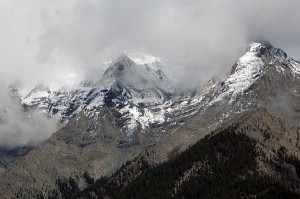Home »

Winter safety in the backcountry
A group of agencies with a mandate for public safety are joining together to provide information to help British Columbians stay safe in the backcountry during the upcoming winter season.
Representatives from the BC Coroners Service, Environment Canada, Parks Canada and the Canadian Avalanche Centre are highlighting the risks and stressing the need for proper planning, equipment, training and monitoring of weather and snow conditions before venturing into the backcountry.
“Research looking at coroners’ statistics shows that an average of 10 persons die each year in B.C. while engaged in winter activities like skiing, snowboarding or snowmobiling,” says chief coroner Lisa Lapointe. “Another 15 or more persons die each year from hypothermia or exposure to cold. These are numbers we all need to work together to reduce.”
 Peter Marshall, public avalanche forecaster with the Canadian Avalanche Centre (CAC), notes there are some bright spots on the horizon. “There has been a steady decline in the number of avalanche fatalities over the past four years,” Marshall said. “This is especially significant as the use of the winter backcountry has increased significantly during that period.”
Peter Marshall, public avalanche forecaster with the Canadian Avalanche Centre (CAC), notes there are some bright spots on the horizon. “There has been a steady decline in the number of avalanche fatalities over the past four years,” Marshall said. “This is especially significant as the use of the winter backcountry has increased significantly during that period.”
Marshall says the goal of the CAC is to ensure that everyone going into mountainous backcountry carries essential safety gear and knows how to use it, has taken basic safety training, and knows how to check bulletins for weather and avalanche risk before heading out.
David Jones, warning preparedness meteorologist with Environment Canada, notes that weather in B.C.’s backcountry can turn nasty fast.
 “Calm, clear weather can quickly deteriorate into blowing and drifting snow with driving winds and near-zero visibility,” Jones said. “Those venturing into the backcountry need to ‘know before they go’ and check the forecasts specifically for backcountry areas, not just for the nearest large cities.”
“Calm, clear weather can quickly deteriorate into blowing and drifting snow with driving winds and near-zero visibility,” Jones said. “Those venturing into the backcountry need to ‘know before they go’ and check the forecasts specifically for backcountry areas, not just for the nearest large cities.”
Grant Statham, mountain risk specialist for Parks Canada, stresses the need for checking avalanche terrain ratings along with the weather forecasts.
The Mountain National Parks comprise 23,000 square kilometres of wilderness in the B.C. and western Alberta mountains, with Parks Canada providing avalanche terrain ratings for more than 350 specific backcountry tours and climbs.
Know Before You Go: Where and when to get the information to plan a safe trip
In order to plan your backcountry trip in advance, you have to be aware of where to get the latest, best weather information. According to the following timeline, you can choose to use/access different tools:
1. Speak to an Environment Canada meteorologist – four to seven days prior to your departure. Available at 1-900 565-5555 or 1-888-292-2222.
Environment Canada’s Pacific Storm Prediction Centre offers one-on-one consultations with a professional meteorologist. Four to seven days before your departure, call them to: Explain where you’re going, when, and the elevations of travel; Learn if the general weather pattern during your trip will be fair, steady and predictable or highly variable and unpredictably stormy; If the forecast is stormy, start thinking about alternate plans to stay below the tree line, to postpone or to cancel altogether. Ask the meteorologist to notify colleagues so that you can call again later for an update about your trip.
– 24 hours before departure, call to consult with a meteorologist again.
– Request specifics about your trip weather.
– If the forecast is stormy, make a decision to adopt an alternate plan, to postpone or to cancel altogether.
-While there is a fee ($2.99 per minute) to speak directly with a meteorologist, the cost is small when you consider the potential risks associated with backcountry weather changes.
2. Check for Special Weather Statements – issued three days prior to your departure.
Special Weather Statements are intended to advise the public of unusual or inconvenient weather conditions and of potentially hazardous or warning-level weather conditions in the longer-term (i.e., greater than 24 hours from now): https://weather.gc.ca/warnings/SWS_bulletins_e.html?prov=bc
3. Warnings – issued 24 hours prior to your departure.
Environment Canada is the only agency authorized to issue weather warnings. Please note that weather warnings are never issued more than 24 hours in advance, even if severe weather is likely just beyond 24 hours: https://weather.gc.ca/warnings/?prov=bc
From the Canadian Avalanche Centre
– Ensure everyone going into mountainous terrain in winter has essential avalanche safety gear – transceiver, probe and shovel – and knows how to use it.
– Ensure everyone has at least basic training in recognizing avalanche terrain and moving safely in that environment.
– Ensure everyone travelling in the backcountry checks weather and avalanche bulletins before heading out. Then choose appropriate terrain for the conditions of the day.
From Parks Canada
– Know Before You Go.
– Does your group have the skills, knowledge and training to travel in avalanche terrain?
– Can you self-rescue? Do you have a plan?
– Do you know the emergency number?
– Have you left an itinerary with someone? Do you have any other route options?
– Again, have you the correct equipment, and have you checked the avalanche and weather forecasts?
For more information, visit: www.parksmountainsafety.ca
From Emergency Management BC
For a one-stop shop of information and links on backcountry safety, visit Emergency Info BC:
https://www.emergencyinfobc.gov.bc.ca/campaigns/backcountry-safety.html
Take the advice with you by adding the mobile site to your Smartphone home screen.
From the Medical Unit, BC Coroners Service
Hypothermia (as it relates to backcountry travel)
When core body temperature gets below 35 degrees Centigrade (normal is 37 C or 98.6 F), usually as a result of immersion in cold water or exposure to cold air.
It can come on insidiously, especially in children and the elderly who are at higher risk.
Hypothermia may present as shivering initially and as it becomes more profound that person may stop shivering and become confused and feel tired, unaware they are so cold.
First Aid
– Hypothermic individuals should be taken to a warm area. Remove any wet clothes.
– Have them drink warm liquids and cover them with warm clothes or blankets.
– Confused, weak individuals should be taken to a medical facility as soon as possible.
Prevention of Hypothermia
Wear layered clothing and a hat outside in cold weather. An inner layer that will wick away moisture is best as wet clothes lead to more rapid development of hypothermia.
Make sure your children are warmly dressed and pay attention as to how long you let them play outside.
When travelling by car in bad weather, let someone know where you are going. Have simple items in the car including blankets or sleeping bags, matches and candles, water and dry food. If stuck, you can run the car for 10 minutes every hour to warm it up.
Be very cautious of alcohol ingestion if going out in the cold, as it increases your risk of developing hypothermia and decreases your awareness that it is happening.
Submitted







